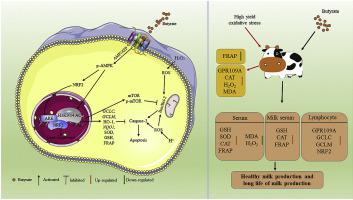当前位置:
X-MOL 学术
›
Free Radical Bio. Med.
›
论文详情
Our official English website, www.x-mol.net, welcomes your
feedback! (Note: you will need to create a separate account there.)
Butyrate alleviates oxidative stress by regulating NRF2 nuclear accumulation and H3K9/14 acetylation via GPR109A in bovine mammary epithelial cells and mammary glands.
Free Radical Biology and Medicine ( IF 7.1 ) Pub Date : 2020-01-21 , DOI: 10.1016/j.freeradbiomed.2020.01.016 Wenjin Guo 1 , Juxiong Liu 1 , Jingxuan Sun 1 , Qian Gong 1 , He Ma 1 , Xingchi Kan 1 , Yu Cao 1 , Jianfa Wang 2 , Shoupeng Fu 1
Free Radical Biology and Medicine ( IF 7.1 ) Pub Date : 2020-01-21 , DOI: 10.1016/j.freeradbiomed.2020.01.016 Wenjin Guo 1 , Juxiong Liu 1 , Jingxuan Sun 1 , Qian Gong 1 , He Ma 1 , Xingchi Kan 1 , Yu Cao 1 , Jianfa Wang 2 , Shoupeng Fu 1
Affiliation

|
Oxidative stress consistently affects lactation length and quality in dairy cows. Oxidative stress in the mammary gland of high-yielding dairy cows is a serious problem. Therefore, we studied the role of butyrate in dairy cow oxidative stress and further elucidated the mechanism of the antioxidative action of mammary epithelial cells in dairy cows. Oxidative stress and activated GPR109A were present in high-yielding dairy cows. Then, bovine mammary epithelial cells (BMECs) were isolated, and oxidative stress-related protein expression was measured, confirming that sodium butyrate (NaB) exerted antioxidant effects through GPR109A, NRF2 and H3K9/14 acetylation. To further study the antioxidative mechanism of butyrate in dairy cows, we also confirmed that butyrate promoted NRF2 nuclear accumulation and H3K9/14 acetylation through the AMPK signaling pathway by western blotting. Additionally, we preliminarily clarified the interaction between NRF2 and H3K9/14 acetylation by Co-IP and ChIP. Butyrate activated the AMPK signaling pathway through GPR109A to promote NRF2 nuclear accumulation and H3K9/14 acetylation, subsequently exerting antioxidant effects through the synergistic functions of these two processes. Then, we studied the effect of butyrate on oxidative stress in dairy cows in vivo, and the results were consistent with those in vitro. Therefore, butyrate played an antioxidant and antiapoptotic role through the GPR109A/AMPK/NRF2 signaling pathway, while H3K9/14 acetylation could promote NRF2 transcription and enhance the antioxidant capacity of BMECs.
中文翻译:

丁酸酯通过调节牛乳腺上皮细胞和乳腺中的NRF2核积累和经由GPR109A的H3K9 / 14乙酰化来减轻氧化应激。
氧化应激会持续影响奶牛的泌乳时间和品质。高产奶牛的乳腺中的氧化应激是一个严重的问题。因此,我们研究了丁酸盐在奶牛氧化应激中的作用,并进一步阐明了奶牛乳腺上皮细胞抗氧化作用的机制。高产奶牛中存在氧化应激和活化的GPR109A。然后,分离牛乳腺上皮细胞(BMECs),并测量氧化应激相关蛋白的表达,证实丁酸钠(NaB)通过GPR109A,NRF2和H3K9 / 14乙酰化发挥抗氧化作用。为了进一步研究奶牛中丁酸酯的抗氧化机理,我们还证实了丁酸通过AMPK信号通路通过Western blotting促进了NRF2核积累和H3K9 / 14乙酰化。此外,我们初步阐明了通过Co-IP和ChIP进行NRF2和H3K9 / 14乙酰化之间的相互作用。丁酸酯通过GPR109A激活AMPK信号通路,以促进NRF2核积累和H3K9 / 14乙酰化,随后通过这两个过程的协同功能发挥抗氧化作用。然后,我们在体内研究了丁酸盐对奶牛氧化应激的影响,结果与体外实验结果一致。因此,丁酸通过GPR109A / AMPK / NRF2信号通路发挥抗氧化和抗凋亡的作用,而H3K9 / 14乙酰化可以促进NRF2转录并增强BMEC的抗氧化能力。
更新日期:2020-01-21
中文翻译:

丁酸酯通过调节牛乳腺上皮细胞和乳腺中的NRF2核积累和经由GPR109A的H3K9 / 14乙酰化来减轻氧化应激。
氧化应激会持续影响奶牛的泌乳时间和品质。高产奶牛的乳腺中的氧化应激是一个严重的问题。因此,我们研究了丁酸盐在奶牛氧化应激中的作用,并进一步阐明了奶牛乳腺上皮细胞抗氧化作用的机制。高产奶牛中存在氧化应激和活化的GPR109A。然后,分离牛乳腺上皮细胞(BMECs),并测量氧化应激相关蛋白的表达,证实丁酸钠(NaB)通过GPR109A,NRF2和H3K9 / 14乙酰化发挥抗氧化作用。为了进一步研究奶牛中丁酸酯的抗氧化机理,我们还证实了丁酸通过AMPK信号通路通过Western blotting促进了NRF2核积累和H3K9 / 14乙酰化。此外,我们初步阐明了通过Co-IP和ChIP进行NRF2和H3K9 / 14乙酰化之间的相互作用。丁酸酯通过GPR109A激活AMPK信号通路,以促进NRF2核积累和H3K9 / 14乙酰化,随后通过这两个过程的协同功能发挥抗氧化作用。然后,我们在体内研究了丁酸盐对奶牛氧化应激的影响,结果与体外实验结果一致。因此,丁酸通过GPR109A / AMPK / NRF2信号通路发挥抗氧化和抗凋亡的作用,而H3K9 / 14乙酰化可以促进NRF2转录并增强BMEC的抗氧化能力。











































 京公网安备 11010802027423号
京公网安备 11010802027423号